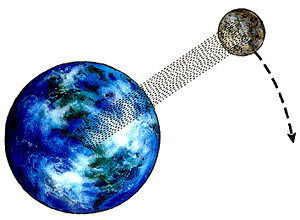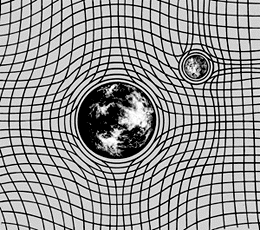|
|
|||
|
..
Popular Mechanics What goes up must come down. Well,
maybe not.
Later this month, NASA researchers hope to conduct an experiment that could determine if the force of gravity might someday be adjusted, like the volume of a radio. The space agency says that turning down the gravity in the immediate vicinity of a rocket would enable future spacecraft to roam the galaxy by using the tug of distant planets and stars. Scientists have historically dismissed talk of antigravity machines as utter nonsense. But at a rare, closed-door conference at NASA's Lewis Research Center in Cleveland, Ohio, scientists representing major universities, national weapons laboratories, defense contractors and the corporate research and development community gathered to hear a detailed account of the space agency's progress in attempting to build a machine that once seemed beyond the bounds of possibility. In a surprising departure from its long-standing policy of openness, NASA did not invite the press to the conference. However, after interviews with attendees, POPULAR MECHANICS has learned that a group of researchers at NASA's Marshall Manned Space Flight Center in Huntsville, Alabama, has nearly completed building a device that could make it possible to reduce gravitational attractions in its immediate vicinity. Part of the reason for the secrecy is that the very thought of such a machine defies conventional scientific wisdom. To understand why, it's helpful to know there are two complementary but not entirely compatible explanations for gravity. Isaac Newton, the first physicist, described gravity as an attraction between two masses (see illustration at top of page). Albert Einstein's general theory of relativity suggests mass actually causes space-time to warp around it. Imagine, for instance, the indentation created by placing a bowling ball on a soft bed. Both theories explain why apples fall from trees. Scientists consider Einstein's theory superior because it explains also why light - which has no mass - appears to bend in strong gravitational fields. Light, as the theory goes, follows the mass-induced curve in space-time (see illustration on opposite page). Viewing gravity this way makes it more of a feature of the universe. It is for this reason that scientists consider the idea of an antigravity device preposterous.
Well, most scientists, anyway.
Ron Koczor, a researcher at NASA's Marshall Space Flight Center, who co-authored
a paper on the Huntsville laboratory's gravity modification device that
was presented at the conference, picks up the story.
"In 1992, Dr. Eugene Podkletnov of Tampere University, Finland, published the results of his experiment with high-temperature ceramic superconductors," Koczor says. "He devised an experiment in which a disc of superconducting material was magnetically levitated and rotated at high speed, up to several thousand rpm, in the presence of an external magnetic field. In the course of the tests, Podkletnov noted that objects above the rotating disk showed a variable but measurable loss of weight, from less than .5 percent to about 2 percent. He had no explanation," explains Koczor. Podkletnov collected data from his experiments for nearly four years and compiled it in a paper that was accepted for publication in the prestigious Journal of Physics. But the paper never appeared. Several days before its scheduled publication in the fall of 1996, Podkletnov told his story to the London Sunday Telegraph. Other reporters attempting to confirm the story learned that one of Podkletnov's co-authors claimed to have never worked on the project. Podkletnov withdrew his paper and returned to the faculty of the Moscow Chemistry Science Research Centre. For many journalists, the situation was beginning to look like the cold fusion debacle. They quickly backed off from the story. Not everyone was dissuaded by Podkletnov's refusal to publish his work. Seven years earlier, Ning Li, a theorist who worked with NASA's Marshall center, had developed a theory suggesting that a superconductor rotated in a strong magnetic field could disrupt the gravitational force in its immediate vicinity. Three of her papers were subsequently published by major scientific journals. Currently a senior scientist on the research faculty of the University of Alabama in Huntsville, she has been helping to build the superconducting disc for the Marshall antigravity device for the past year. Whitt Brantley, the NASA-designated spokesman for the experiment who also is a member of the antigravity project, says the space agency's scientists decided last year to try to duplicate Podkletnov's machine by looking over his earlier research and exchanging information with him by telephone and e-mail. "Each time we contact him there seems to be more detail. It's sort of like chasing something," says Brantley. NASA isn't sure its antigravity machine, which is 90 percent complete, will work. At the moment, the biggest problem is building the fragile superconducting disc, which is, in fact, made of two discs, explains Brantley. One is made of metal that can be levitated in a magnetic field. On top of it is a composite made of superconducting materials. This assembly is housed in a 20-in.-dia. column that stands about 4 ft. tall. At the start of the experiment, it will be filled with liquid helium or nitrogen, which cools the apparatus to minus-400 degreesF. Only then is the disc set into motion. If the machine performs as Podkletnov claims, delicate instruments will show a diminution of gravity's tug. Brantley says researchers originally saw a slight gravity shielding effect when they placed instrumentation above a smaller, stationary disc. It turned out to be the result of the magnetic field. Adding ordinary 1/2-in. iron plates removed this anomaly. Some critics contend that if Podkletnov had taken a similar precaution, the effects that he observed would have likewise disappeared. Most physicists believe that when NASA flips the switch on its gravity modification experiment, absolutely nothing will happen. Then again, it could start the countdown to a bold new era in space exploration. ..
.. http://www.popularmechanics.com/science/research/1281621.html |
|||
| FAIR USE NOTICE: This page contains copyrighted material the use of which has not been specifically authorized by the copyright owner. Pegasus Research Consortium distributes this material without profit to those who have expressed a prior interest in receiving the included information for research and educational purposes. We believe this constitutes a fair use of any such copyrighted material as provided for in 17 U.S.C § 107. If you wish to use copyrighted material from this site for purposes of your own that go beyond fair use, you must obtain permission from the copyright owner. | |||
|
|



